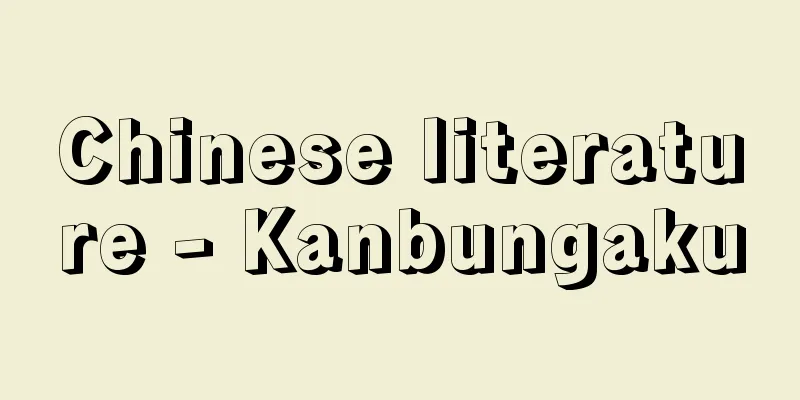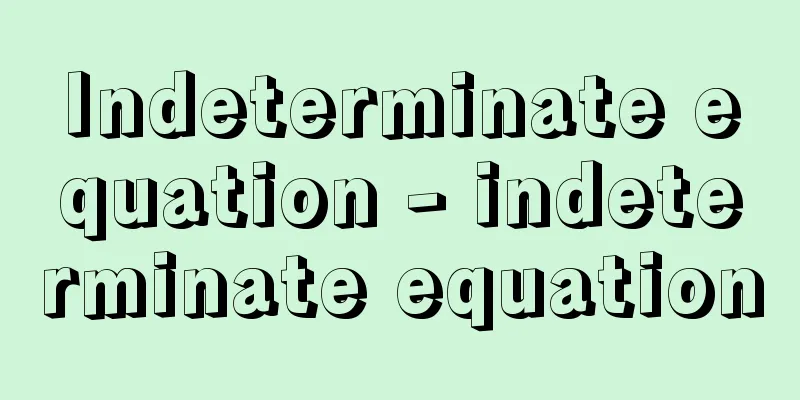Chinese literature - Kanbungaku

|
Chinese poetry and literary Chinese literature created by Japanese people. It goes without saying that Chinese literature is the expression of Japanese thoughts and feelings by Japanese people using the Chinese language and characters, but Japanese people have revered and absorbed Chinese literature and have worked to develop their own country's literature. For this reason, they have paid close attention to the changes in Chinese literature and have repeatedly followed new trends and imitated them, so it is hesitant to claim that it is a literature unique to Japan. Its distinctive feature is its dual nature of borrowing its form from China and incorporating Japanese elements into its content. [Shosuke Ozone] Nara periodThe dawn of Chinese literature in Japan is thought to be the Asuka period, but it was not yet mature enough to produce works of pure literature. According to the preface to "Kaifuso," during the Omi period, literary scholars were invited to the imperial court to compose poems for the emperor and his subjects to sing in unison, and it is believed that many of these poems were in praise of Shotoku, as seen in the work of Prince Otomo, who wrote the first Chinese poems in Japan. After the Jinshin War, Prince Otsu and Emperor Mommu came to power, and poems were composed at banquets and on imperial orders, mainly at the imperial court, but also rhyming poems appeared under the influence of the poetry of the Six Dynasties period. In the Nara period, the focus of poetry parties shifted to political powers, and poets were invited to the Saho residence of Nagaya no Okimi and the Suge residence of Fujiwara no Muchimaro to compete with each other in their poetic talents. Their poems show the influence of works from the early Tang Dynasty, but their intake of Chinese literature was generally superficial, and limited to the use of simple words and phrases. The oldest surviving anthology, Kaifuso, allows us to grasp the full picture of ancient poetry. Meanwhile, in classical Chinese, benrei style writing can be seen in Tang Yamato Jotoseiden, the preface to the Manyoshu, and the Keikokushu's countermeasures (essays for the highest examination for government official recruitment). [Shosuke Ozone] Heian PeriodIn the early Heian period, Tang-style culture entered its golden age thanks to the encouragement of academic culture by Emperors Kanmu and Saga. Based on the literary ideal that "writing is a great undertaking for governing the country and an enduring feat" (preface to the Ryōunshū), three imperial anthologies were compiled: the Ryōunshū, Bunka Shūreishū, and Keikokushū. At the time, poetry parties were frequently held at the imperial court and in villas, and with the increase in Chinese poetry anthologies imported, new trends in poetic styles and forms were adopted, and many of the poems that were created were several steps ahead of those of the Nara period. The poetry world of this period was centered around Emperor Saga and consisted of literati bureaucrats such as Ono no Minemori and Sugawara no Kiyokimi, and had the character of court literature. Of particular note is Kukai, who was active in many fields and wrote works such as "Henjo Hokki Shoryoshu", "Bunkyou Hifuron", and "Sangoshiki". Chinese literature changed the traditional style of poetry completely when "Bai Juyi Wenshu" was introduced in the following Jowa period (834-848). Furthermore, when the founding of the Monshoin School established the academic world, the literary world developed around scholar-poets. After Ono no Takamura, who was rich in anecdotes, Miyako no Yoshika, who wrote "Tosi Bunshu" that took up folklore, and Shimada no Tadaomi, who was praised as a contemporary poet for his "Den Shi Kashu", Sugawara no Michizane appeared. Michizane, the author of "Kanke Bunso" and "Sanke Goshu", pioneered new poetic realms in the two remote areas of Sanuki and Dazaifu, where he frankly expressed his own feelings, and it was this natural poet who first gave birth to Japanese-style Chinese poetry. Although there were other poets in his time, such as Kino Haseo and Miyoshi Kiyoyuki, as waka poetry prospered, Chinese poetry also began to take on a more Japanese style, and a sense of beautiful writing that emphasized expression came to dominate. During the Tenryaku period (947-957), Oe no Asatsuna and Sugawara no Fumitoki were praised for their elegant and beautiful poems, while Minamoto no Shitago, who was from a family of origins, and his disciple Minamoto no Tamenori, who attempted to establish a new line of scholars, made a great contribution with their enlightening writings. The activities of the poets of the next Ichijo period, Oe no Masahira, Koretoki, and Ki no Tadana, are known through works such as "Honcho Reiso". After that, Chinese poetry and prose rapidly declined, but in the late Heian period, Fujiwara no Akihira and Oe no Masafusa, who were prolific and engaged in a wide range of literary activities, are noteworthy. It has been pointed out that Chinese literature of this period depicted the customs of the common people, that poems praising Buddhism were written to reflect the uneasy social climate, and that educational books for beginners were produced in large numbers. [Shosuke Ozone] middle agesIn the Kamakura period, emphasis was placed on the study of the sutras rather than literature, and no outstanding poets emerged, so there was nothing worth seeing. However, among the nobility, there were poetry gatherings, poetry contests, and linked verse (two or more people gathering together and each writing a verse to complete a poem), and on the other hand, selections of excellent verses, anthologies of historical wise sayings, and books on writing poetry were written, but rather, the literature of chanting by such authors as Choken and Kaie is more prominent. However, this period is represented by Gozan literature. The custom of composing poetry and prose in Zen temple life was brought about by Issan Ichinei and others who came to Japan as naturalized citizens at the end of the Kamakura period, and a new style of poetry was born as monks such as Sesson Yubai and Chugan Engetsu entered the Zen temple one after another. Then, famous Yuan monks such as Seisetsu Shocho, Minki Soshun, and Jikusen Bonsen came to Japan, and the exchange of letters and elegant ideas continued, leading to rapid development of Zen literature. Meanwhile, the erudite Kokan Shiren, who inherited and perfected the old traditions, wrote many enlightening books, including the monk's history "Genko Shakusho" and the poetry and prose collection "Saibokushu". It reached its peak in the early Muromachi period with Gido Shushin and Zekkaichishin. Gido, who displayed a sophisticated style supported by his wide knowledge and deep contemplation, produced "Kugeshu," while Zekkai, known for his refined style of poetry and ingenious 46-style prose, produced "Shokenko." Through the efforts of these two poets, Japanese poetry reached a level comparable to that of Chinese poetry. Following in their footsteps were Isho Tokugan, the Jiangxi Longpa, Zuikei Shuho, Yokokawa Keizo, Ten'in Ryutaku, Keijo Shurin, the mad monk Ikkyu Sojun, and the founder of Nangaku, Keian Genju, but their style remained largely unchanged and their impact was shallow. They held a lot of poetry gatherings and poetry meetings, and also wrote annotations on Chinese classics. They read and lectured on "Santai Shi" and "Kobun Shinpo" as books of culture, and many of them remain as excerpts. It is also unforgettable that their cultural project, the Gozanban, was extremely popular. [Shosuke Ozone] Edo periodIn this era, Confucian poets were a type of professional who wrote Chinese poetry and prose. Fujiwara Seika, a pioneer of early modern literature, advocated Neo-Confucianism, but his view of literature belonged to the Saido school, which believed that literature should exalt morality, and his works lacked artistic elegance. The same could be said of his disciples, the erudite and enlightened Hayashi Razan, the skilled writer Hori Kyoan, Nawa Kassho, who was famous for publishing old movable type, and Matsunaga Sekigo, who followed in his master's footsteps, and could be said to be more scholars than poets. As poets, Ishikawa Jozan, known as the Li Du of the East, and the sentimental monk Gensei were the twin masterpieces. Among the students of Shakugo were such talented poets as Kinoshita Jun'an, Ando Se'an, and Kaibara Ekiken, but Jun'an, who was highly acclaimed as a famous Confucian scholar, especially valued Tang poetry and loved the writings of Han Tuizhi and Ryu Sogen, and among his students were Arai Hakuseki, who was also famous as a scholar of economics, Muro Kyuso, known for his writings on the Classics, Gion Nankai, who composed 100 poems in one night, and Amenomori Hoshu, who was well versed in Chinese language. Among the students of Ito Jinsai, a member of the Kogido school who broke away from the exhortation-based view of Neo-Confucianism and placed the focus of literature on the expression of human feelings, were his eldest son Togai and Okuda Sankaku. However, during the Genroku period (1688-1704), when literature flourished, Ogyu Sorai, who advocated classical literature and exalted the way of elegance, produced such scholar-poets as Dazai Shundai, Hattori Nankaku, Hirano Kinka, Takano Rantei, the monk Daicho, and the monk Ban'an, who became all the rage. Sorai considered the study of classics by elucidating ancient language to be the first priority, advocated the abolition of the study of Chinese pronunciation and the long-standing practice of reading Chinese classics in Japanese, and placed importance on expressive rhetoric and was particular about pseudo-classical writing. As a result, the "Tangshisen" became very popular, replacing the traditional "Kobun Shinpo" and "Santai Shi." Other well-known poets include Akiyama Gyokuzan, Yanada Zeigan, Toriyama Shiken, and Katsurayama Saigan. In the late Edo period, professional poets appeared, poetry societies were formed, many poetry collections were published, and talented poets appeared in the provinces. Emura Hokkai of Kyoto Shijo-sha, a Neo-Confucian school poet, excelled in poetry along with his brother Seita Danso, Katayama Hokkai of Osaka Konton-sha included Shibano Ritsuzan, Bito Jishu, and Koga Seiri, three of the Kansei scholars, and Kikuchi Gozan, Ookubo Shibutsu, and Kashiwagi Jotei were well known among the students of Ichikawa Kansai of Edo Koko-sha. Yamamoto Kitayama, a member of the Eclectic School of Evidence Research, preached the theory of the soul and attacked the Kobunji School, but his followers included Kameda Hosai and Ota Kinjo, and his disciple Yanagawa Seigan of Gyokuchiginsha, whose disciples Onuma Makurazan, Onokozan, and Mori Shuntou dominated the poetry world from the end of the Edo period to the Meiji period. However, the greatest poet of the time was Kan Sazan, and in his lineage were Rai Sanyo and Fujii Chikugai, who were famous for their historical poems. Hirose Tanso, known as the poetic saint of the Kaisei region, and his younger brother Kyokuso were also talented poets. Poets emerged from all over the country, ushering in the heyday of Chinese poetry, but there was no unified style of poetry, and individual works were appreciated. With the import of Western culture during the Meiji period, Chinese literature gradually declined. [Shosuke Ozone] "History of Japanese Chinese Literature" by Masayuki Okada (1954, Yoshikawa Kobunkan) [Reference items] | | | | | | |Seven-word quatrain. 1627 (Kan'ei 4) Artwork 24.5 x 43.5 cm Aichi Prefectural Museum of Art (Kimura Teizo Collection) Jozan Ishikawa "Continuation of Echoes" Source: Shogakukan Encyclopedia Nipponica About Encyclopedia Nipponica Information | Legend |
|
日本人の創作した漢詩および文学的な漢文。漢文学は日本人が中国の言語文字を用いて、日本人の思想感情を表現したものであることはいうまでもないが、中国の文学を崇拝、摂取して、自国の文学の発展に努力してきた。そのため中国文学の変遷に留意し、新しい傾向を追って模倣を重ねてきたので、日本独自の文学と断定することは躊躇(ちゅうちょ)される。その形式は中国に借りて、内容に日本のものを盛り込むという二重の性格をもつのがその特色である。 [大曽根章介] 奈良時代日本の漢文学の黎明(れいめい)は飛鳥(あすか)時代と思われるが、まだ純文学の作品を生み出すほど成熟していない。『懐風藻(かいふうそう)』序によると、近江(おうみ)朝では宮廷に文学の士を招いて君臣唱和の詩が詠ぜられたとあるが、日本初の漢詩である大友皇子の作品から聖徳(しょうとく)賛美のものが多かったと思われる。壬申(じんしん)の乱後、大津皇子や文武(もんむ)天皇が登場し、宮廷を中心にして侍宴応詔(宴席にはべり勅命によって詩を詠む)の詩が詠まれたが、六朝(りくちょう)詩の影響を受けて詠物詩も現れる。奈良時代になると詩宴の中心が政治権力者に移行し、長屋王(ながやのおおきみ)の佐保(さほ)邸や藤原武智麻呂(むちまろ)の習宜(すげ)の別邸に詩人たちが招かれて詩才を競った。彼らの詩には初唐の作品の影響もみられるが、一般的に中国文学の摂取も皮相的で、単なる語句の使用にとどまっている。現存最古の総集『懐風藻』によって、上代の詩の全貌(ぜんぼう)をつかむことができる。一方、漢文では『唐大和上東征伝(とうだいわじょうとうせいでん)』や『万葉集』の序、『経国集(けいこくしゅう)』の対策(官吏登用のための最高試験の論文)などに駢儷(べんれい)文がみえる。 [大曽根章介] 平安時代平安初期には桓武(かんむ)・嵯峨(さが)両天皇による学問文化の奨励によって、唐風文化は黄金期を迎える。「文章は経国の大業にして不朽の盛事なり」(『凌雲集(りょううんしゅう)』序)の文学理念のもとに、『凌雲集』『文華秀麗集』『経国集』の勅撰(ちょくせん)三集が編纂(へんさん)された。当時宮廷や離宮では頻繁に詩宴が催され、また舶載された中国詩集の増加に伴って新傾向の詩風や詩体が受容され、つくられた多くの詩編は奈良時代より数段進歩した。この時代の詩壇は、嵯峨天皇を中心にして小野岑守(おののみねもり)、菅原清公(すがわらのきよきみ)など文人官僚によって構成されており、宮廷文学的性格をもっている。注目すべきは『遍照発揮性霊集(へんじょうほっきしょうりょうしゅう)』『文鏡秘府論(ぶんきょうひふろん)』『三教指帰(さんごうしいき)』などの著者で、多方面で活躍した空海である。漢文学は次の承和(じょうわ)期(834~848)に『白氏文集(はくしもんじゅう)』が渡来してから、従来の詩風を一変した。しかも、文章院の創立により学者の家が確立すると、文壇が学者詩人を軸にして展開する。種々の逸話に富む小野篁(おののたかむら)、民間伝承を取り上げた『都氏文集(としぶんしゅう)』の都良香(みやこのよしか)、当代の詩匠とたたえられた『田氏家集(でんしかしゅう)』の島田忠臣(しまだのただおみ)などを経て菅原道真(すがわらのみちざね)が登場する。『菅家文草(かんけぶんそう)』『菅家後集』の著者である道真は、讃岐(さぬき)、大宰府(だざいふ)の二度の僻地(へきち)で新しい詩境を開拓し、率直に自己の感情を吐露しているが、この天性の詩人によって初めて日本固有の漢詩が誕生した。同時代に紀長谷雄(きのはせお)や三善清行(みよしきよゆき)がいるが、和歌の隆盛に伴って漢詩も和風化の傾向を強め、表現を重視する美文意識が支配する。天暦(てんりゃく)期(947~957)の大江朝綱(おおえのあさつな)、菅原文時(ふみとき)の華麗な秀句は人々に賞賛され、一方、累代の学者に対して新しく学者の家を起こそうとする、起家出身の源順(したごう)や弟子の源為憲(ためのり)らは啓蒙(けいもう)的著述で功績が大きい。次の一条(いちじょう)朝の詩人大江匡衡(まさひら)・以言(これとき)、紀斉名(きのただな)らの活躍は『本朝麗藻(れいそう)』などによって知られる。それ以後漢詩文は急速に衰退するが、平安後期では多くの著述によって広範な文学活動を行った藤原明衡(あきひら)と大江匡房(まさふさ)が注目される。この時代の漢文学は庶民風俗が取り上げられたこと、不安な世相を反映して賛仏の詩文が書かれたこと、初学者のための啓蒙書が続出したことが指摘される。 [大曽根章介] 中世鎌倉時代には文学よりも経学が重視され、優れた詩人も登場せず、みるべきものはない。ただ貴族の間で詩会、詩歌合(しいかあわせ)、聯句(れんく)(2人以上が寄り合って各自が一句をつくり、一編の詩を完成すること)が行われ、一方で秀句選や故事金言集、作詩指南書が書かれたが、むしろ澄憲(ちょうけん)や海恵(かいえ)などの唱導文学が注目される。しかしこの時代は五山文学によって代表される。鎌倉末期に来朝帰化した一山一寧(いっさんいちねい)らによって禅林生活における詩文制作の風習がもたらされ、雪村友梅(せっそんゆうばい)、中巌円月(ちゅうがんえんげつ)らの入元僧が相次ぎ、新しい詩風が生み出された。そして清拙正澄(せいせつしょうちょう)、明極楚俊(みんきそしゅん)、竺仙梵僊(じくせんぼんせん)ら元の名僧の渡来により文雅の交遊が続けられ、禅林文学は急速な発展を遂げる。一方古い伝統を継承し発展完成させた博学な虎関師錬(こかんしれん)は僧史の『元亨釈書(げんこうしゃくしょ)』、詩文集『済北集(さいほくしゅう)』のほかに多くの啓蒙書も書いている。そして室町初期に義堂周信(ぎどうしゅうしん)と絶海中津(ぜっかいちゅうしん)によって最高峰に到達する。広い学識と深い観照に支えられて巧緻(こうち)な作風を示した義堂には『空華集(くうげしゅう)』があり、洗練された詩風と巧妙な四六文で知られた絶海には『蕉堅藁(しょうけんこう)』があり、2人の活躍によって中国の詩に比肩しうる境地に到達した。彼らの跡を受けて惟肖得巌(いしょうとくがん)、江西龍派(こうせいりゅうは)、瑞渓周鳳(ずいけいしゅうほう)、横川景三(おうせんけいさん)、天隠龍沢(てんいんりゅうたく)、景徐周麟(けいじょしゅうりん)や、風狂僧一休宗純(いっきゅうそうじゅん)、南学の祖桂菴玄樹(けいあんげんじゅ)らが活躍するが、作風の変化に乏しく感動が浅い。聯句会や詩会が盛んに開催され、漢籍の注釈も行われた。『三体詩』や『古文真宝』が教養書として愛読講義され、その多くは抄物(しょうもの)として残っている。また彼らの文化事業として五山版が盛況を極めたことも忘れられない。 [大曽根章介] 江戸時代この時代は儒者詩人という一種の職業人が漢詩文の作者であった。近世文運の開拓者藤原惺窩(せいか)は朱子学を提唱したが、その文学観は文学は道徳を顕彰すべきものだという載道(さいどう)派に属するもので、その作品は芸術的雅趣に乏しい。これはその弟子の博識な啓蒙家林羅山(らざん)、文章に優れた堀杏庵(きょうあん)、古活字版の刊行で名高い那波活所(なわかっしょ)、師の衣鉢を継いだ松永尺五(せきご)も同じで、詩人よりも学者といえる。詩人としては日東の李杜(りと)と称された石川丈山と情趣豊かな僧元政(げんせい)が双璧(そうへき)である。尺五の門下に木下順庵(じゅんあん)、安東省庵(せいあん)、貝原益軒(えきけん)らの逸材が輩出したが、名儒の誉れが高い順庵はもっぱら唐詩を尊び韓退之(かんたいし)、柳宗元(りゅうそうげん)の文章を愛し、その門人に経世家としても名高い新井白石、経学文章で知られた室鳩巣(むろきゅうそう)、一夜に100首を詠んだ祇園南海(ぎおんなんかい)、華語に明るい雨森芳洲(あめのもりほうしゅう)など木門十哲(ぼくもんじってつ)といわれる詩人が出て活躍した。朱子学の勧懲的見解から脱して文学の主眼を人情の表出に置いた古義堂派の伊藤仁斎(じんさい)の門下から嫡子東涯(とうがい)や奥田三角(さんかく)などが現れた。しかし文芸が活気を呈した元禄(げんろく)期(1688~1704)に古文辞学を提唱し風雅の道を顕彰した荻生徂徠(おぎゅうそらい)の門には太宰春台(だざいしゅんだい)、服部南郭(はっとりなんかく)、平野金華(きんか)、高野蘭亭(らんてい)、僧大潮(だいちょう)、僧万庵(ばんあん)らの学者詩人が輩出して一世を風靡(ふうび)した。徂徠は古語の解明によって古典を研究することを第一義と考え、華音の学習と長い間行われてきた漢文訓読の廃止を説き、表現修辞を重んじ擬古に心がけた。そのため従来の『古文真宝』『三体詩』にかわって『唐詩選』が大いに流行した。そのほか詩人として秋山玉山(ぎょくざん)、梁田蛻巌(やなだぜいがん)、鳥山芝軒(しけん)、桂山彩巌(かつらやまさいがん)も知られる。 江戸後期には専門詩人が登場し詩の結社が生まれ、詩集の出版も多く、地方に優秀な詩人が現れた。朱子学派の京都賜杖(しじょう)社の江村北海(えむらほっかい)は弟清田儋叟(せいたたんそう)とともに詩に優れ、大坂混沌(こんとん)社の片山北海の門には寛政(かんせい)の三博士柴野栗山(しばのりつざん)、尾藤二洲(びとうじしゅう)、古賀精里(こがせいり)がおり、江戸の江湖(こうこ)社の市河寛斎(かんさい)門には菊池五山、大窪詩仏(おおくぼしぶつ)、柏木如亭(かしわぎじょてい)らが知られる。折衷考証学派の山本北山は性霊(せいれい)説を唱えて古文辞学派を攻撃したが、同系に亀田鵬斎(ほうさい)や太田錦城(きんじょう)、弟子に玉池吟(ぎょくちぎん)社の梁川星巌(やながわせいがん)がおり、その門下の大沼枕山(ちんざん)、小野湖山(こざん)、森春濤(しゅんとう)が幕末から明治の詩壇に君臨する。しかし当代随一の詩人は菅茶山(かんさざん)であり、その系統に史詩で名高い頼山陽や藤井竹外がいる。また海西の詩聖と称された広瀬淡窓(たんそう)や、その弟旭荘(きょくそう)も詩才に優れた。そのほか各地に詩人が輩出し漢詩の全盛時代を迎えたが、それを統一する詩風はなく個性的作品が喜ばれた。明治時代に西欧文化が輸入されるとしだいに漢文学は衰えていった。 [大曽根章介] 『岡田正之著『日本漢文学史』(1954・吉川弘文館)』 [参照項目] | | | | | | |七言絶句。1627年(寛永4) 作品部24.5×43.5cm愛知県美術館(木村定三コレクション)"> 石川丈山『継響』 出典 小学館 日本大百科全書(ニッポニカ)日本大百科全書(ニッポニカ)について 情報 | 凡例 |
<<: Chinese reading - Kanbunkundoku
>>: Kanbun Kaitai - Kanbun Kaitai
Recommend
Inkjet printer
...In a computer, the device that takes in inform...
Sarah (mythology) (English spelling)
...The Romany language has been mixed with region...
Kanose [Hot Spring] - Kanose
...The central settlement, Kurosawa, was formed a...
Pearl anthurium (English spelling)
…It was introduced in the middle of the Meiji per...
Ivy Geranium
...There are groups such as the flower geraniums ...
Charlotte Amalie
…After World War II, tourism became the major ind...
Airbus A300 - Airbus A
...The origin of the word can be said to be in th...
Late payment tax - Entaizei
Tax law has provisions to protect the rights of t...
Affiliated - Affiliated
…When a rock is made up of two groups of minerals...
Corydalis angustifolia - Corydalis angustifolia
A perennial plant of the Papaveraceae (APG classi...
scale
(1) An oxide film that forms on the surface of met...
Ganshoji Temple
This is a Jodo Shinshu Honganji temple. Renjun, th...
Kuomintang-Communist cooperation
This refers to two periods of cooperation between...
Zeng Pu (English spelling)
[Birth] Douji 11 (1872) [Died] 1935 China's fi...
Okihama
...The coast can refer either to the land (broad ...







![Kamojima [town] - Kamojima](/upload/images/67cb406240e29.webp)

